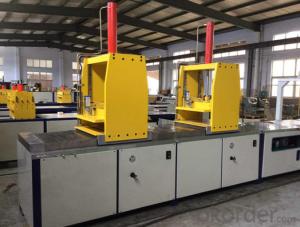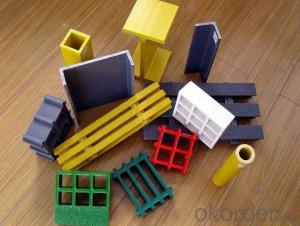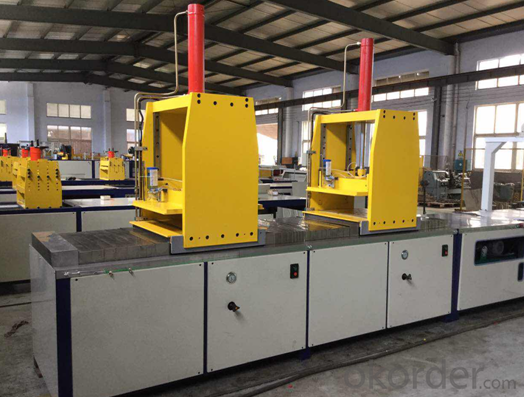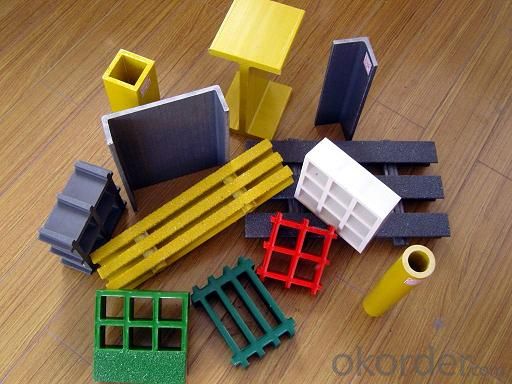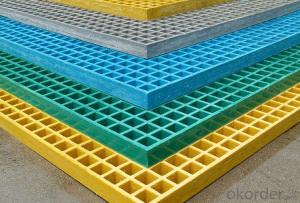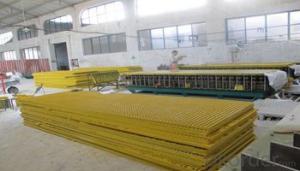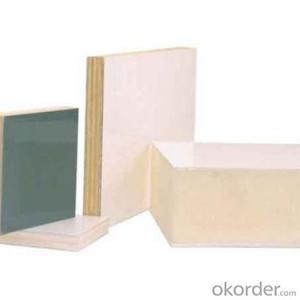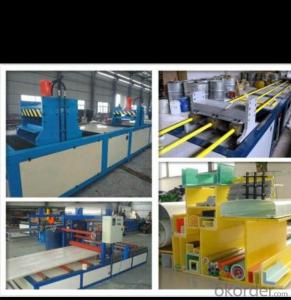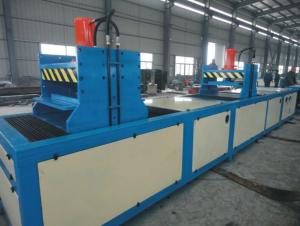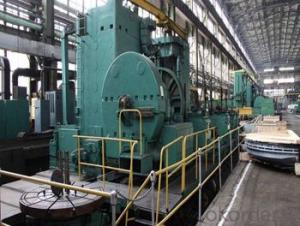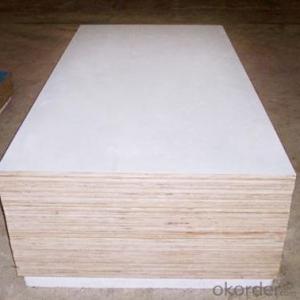FRP Pultrusion Profiles - Lightweight, High Strength, Best Quality FRP Pultruded Grating
- Loading Port:
- Tianjin
- Payment Terms:
- TT OR LC
- Min Order Qty:
- 20000 m.t.
- Supply Capability:
- 100000 m.t./month
OKorder Service Pledge
OKorder Financial Service
You Might Also Like
Specification
PRODUCT DESCRIPTION
Pultruded grating is made by a particular assembly process, which using “I” shape as its main load-bearing and special rod to go through the bearing bar. Pultruded grating include the standard grating and the custom grating, the custom grating can be designed to meet customer’s requirement or special using condition by changing the shape, size and space of the bearing bars, the surface can be covered with lozenge panel, grit panel, or added the anti-slippery sand directly.
FRP pultruded grating has the most characteristics of molded grating, but it has its distinct advantages, it has very high fiberglass content in the loading direction, so it has very high load capability, it has more superiority when used at wide span, so that the basic support will be decreased and the project cost will be reduced accordingly.
SPECIFICATION
The standard space between two crossbars is 6 inch or 12 inch.
Thickness (mm) | Bar width (mm) | Open space (mm) | Open rate (%) | Approx weight (kg/m |
25.4 | 15.2 | 22.8 | 60 | 13.2 |
25.4 | 15.2 | 15.2 | 50 | 15.9 |
25.4 | 15.2 | 10.1 | 40 | 18.5 |
25.4 | 40 | 10.8 | 21 | 14.5 |
38.1 | 15.2 | 22.8 | 60 | 15.8 |
38.1 | 15.2 | 15.2 | 50 | 19.1 |
38.1 | 15.2 | 10.1 | 40 | 22.4 |
50.8 | 25.4 | 25.4 | 50 | 16.6 |
50.8 | 25.4 | 12.7 | 33 | 21.1 |
FEATURES
a. Anti-corrosion and anti-rust
b. Light weight and high strength
c. Anti-flammable
d. Anti- fatigue
e. Safe and anti-slippery
f. Anti-ageing
g. Easy of maintenance
h. Excellent electromagnetism property
i. Good economic benefit
FIELDS SERVED
Sewage treatment,
water supply and drainage,
chemical industry,
oil industry,
power engineering,
pulp and paper,
construction engineering,
spinning, marine engineering.
COMPANT DESCRIPTION
CNBM International Corporation is one subsidiary of CNBM, we focus on offering good-quality products,professional service and complete solution to our customers. Strong delivery capacity, advanced technology& management, strong financing capability and excellent after-sale service are our advantages in sharing international market.
FAQ
Q1.What's your sample policy?
A:We can supply the sample if we have ready parts in stock, but the customers have to pay the courier cost.
Q2.Can you produce according to the samples?
A: Yes, we can produce or modify the products according to your request.
Q3.How do you deliver the goods to my country?
A:We can provide international express, such as DHL, EMS, UPS, FedEx, etc. We select air freight and sea freight upon your requests. Quotations if without mentioning the shipping costs are shipping fee excluded.
Q4.How much does it cost to ship to my country?
A:When you goanna to place an order, please contact us, because different country has different freight.
Q5.How to get the catalogue?
A:please contact us and tell us what you are looking for.
We will try our best to meet customers' demands. Welcome you come here to visit us. We sincerely welcome partners around the world to establish business cooperation with us on the basis of mutual trust, benefit and development.
PICTURES
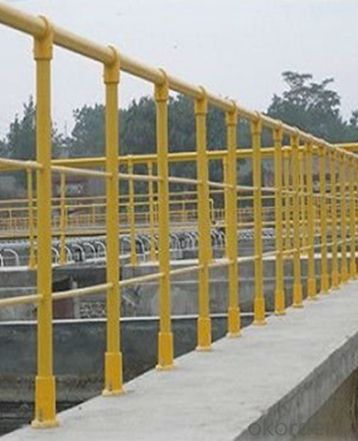

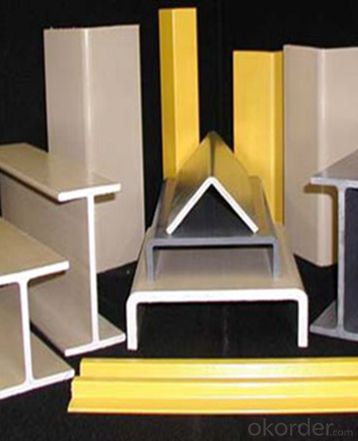
- Q: Can FRP pultrusion profiles be used in the construction of pedestrian bridges?
- Yes, FRP pultrusion profiles can be used in the construction of pedestrian bridges. FRP pultrusion profiles offer several advantages such as high strength, corrosion resistance, low maintenance, and lightweight properties, making them suitable for pedestrian bridge applications. Additionally, the flexibility in design and customization options of FRP pultrusion profiles allows for efficient construction and installation of pedestrian bridges.
- Q: How do FRP pultrusion profiles perform in heavy-load applications?
- FRP (Fiber Reinforced Polymer) pultrusion profiles are known for their exceptional performance in heavy-load applications. Due to their high strength-to-weight ratio, these profiles can withstand substantial loads without compromising structural integrity. The pultrusion process ensures that the fibers are uniformly distributed and aligned along the length of the profile, resulting in superior strength and stiffness. In heavy-load applications, FRP pultrusion profiles exhibit excellent load-bearing capabilities. They have a high modulus of elasticity, meaning they can resist deformation under heavy loads, ensuring long-term durability. These profiles also have a high ultimate tensile strength, allowing them to withstand extreme forces without breaking or deforming. Furthermore, FRP pultrusion profiles are corrosion-resistant, making them ideal for heavy-load applications in harsh environments. Unlike traditional materials like steel, FRP does not rust or corrode, ensuring a longer lifespan and reduced maintenance costs. Another advantage of FRP pultrusion profiles in heavy-load applications is their electrical insulation properties. They do not conduct electricity, making them suitable for environments where electrical conductivity is a concern. Additionally, FRP pultrusion profiles are lightweight compared to traditional materials like steel or concrete. This characteristic not only simplifies transportation and installation but also reduces overall project costs. In summary, FRP pultrusion profiles perform exceptionally well in heavy-load applications. Their high strength-to-weight ratio, excellent load-bearing capabilities, corrosion resistance, electrical insulation properties, and lightweight nature make them a preferred choice for various industries, including construction, infrastructure, marine, and transportation.
- Q: Are FRP pultrusion profiles resistant to ultraviolet radiation?
- Yes, FRP (Fiber Reinforced Polymer) pultrusion profiles are typically resistant to ultraviolet (UV) radiation. The nature of the materials used in FRP profiles, such as fiberglass and resins, provides inherent UV resistance. These profiles are manufactured using a pultrusion process that involves impregnating reinforcing fibers with a UV-resistant resin matrix and then curing them. This combination of materials and manufacturing technique ensures that FRP pultrusion profiles can withstand prolonged exposure to UV radiation without significant degradation or loss of mechanical properties. As a result, FRP pultrusion profiles are commonly used in outdoor applications where UV resistance is essential, such as construction, infrastructure, and marine industries. However, it is important to note that the level of UV resistance can vary based on the specific composition of the FRP profile and the quality of the manufacturing process. Therefore, it is always recommended to consult the manufacturer's specifications and guidelines for the specific product being used to ensure its suitability for UV-exposed environments.
- Q: Are FRP pultrusion profiles resistant to high-pressure water jets?
- Yes, FRP pultrusion profiles are generally resistant to high-pressure water jets due to their inherent corrosion resistance and ability to withstand harsh environmental conditions.
- Q: Are FRP pultrusion profiles resistant to impact from flying debris?
- FRP pultrusion profiles possess notable strength and durability, earning them a reputation in the industry. Their inherent properties make them generally impervious to damage caused by flying debris. This exceptional impact resistance can be attributed to the combination of reinforcing fibers, often fiberglass, and the polymer matrix. The extent of resistance to flying debris impact may vary depending on the design, thickness, and composition of the FRP pultrusion profiles. Nevertheless, these profiles are typically engineered to withstand impact forces and effectively withstand damage from airborne debris. Moreover, FRP pultrusion profiles find extensive use in industries such as construction, transportation, and infrastructure, where impact resistance is of utmost importance. These profiles have undergone rigorous testing and have demonstrated their ability to endure various impact scenarios, making them a trustworthy choice for applications that involve the potential for flying debris. It is vital to recognize that although FRP pultrusion profiles boast commendable impact resistance, the severity of the impact and the speed of the flying debris can still impact the degree of damage incurred. Thus, it is advisable to consult with the manufacturer or an engineer to ensure the chosen FRP profile is suitable for the intended application and potential impact conditions.
- Q: Can FRP pultrusion profiles be used in the mining and mineral processing industry?
- Yes, FRP (Fiber Reinforced Polymer) pultrusion profiles can be used in the mining and mineral processing industry. FRP pultrusion profiles have several properties that make them suitable for use in this industry. Firstly, FRP pultrusion profiles are lightweight yet incredibly strong. This makes them ideal for applications where weight reduction is important, such as in mining equipment or processing plants. Despite their lightweight nature, FRP profiles can withstand heavy loads and resist corrosion, which is particularly beneficial in the mining industry where equipment is exposed to harsh environments and corrosive substances. Secondly, FRP pultrusion profiles are non-conductive and possess excellent electrical insulation properties. This is advantageous in mining and mineral processing operations where electrical safety is paramount. FRP profiles can be used in applications where electrical conductivity needs to be avoided, such as in electrical enclosures or cable trays. Additionally, FRP pultrusion profiles are highly resistant to chemicals, including acids and alkalis. This makes them suitable for use in mineral processing plants where various corrosive chemicals are used in the extraction and processing of minerals. FRP profiles can withstand exposure to these chemicals without deteriorating or experiencing significant damage, prolonging their lifespan and reducing maintenance costs. Furthermore, FRP pultrusion profiles have a high strength-to-weight ratio, which means they can be used to create durable and lightweight structures. This is particularly beneficial in mining operations where structures such as walkways, ladders, and platforms need to be installed in challenging terrains. The lightweight nature of FRP profiles makes them easier to transport, handle, and install compared to traditional materials like steel. In conclusion, FRP pultrusion profiles can be effectively used in the mining and mineral processing industry due to their lightweight, high strength, corrosion resistance, electrical insulation, and chemical resistance properties. These profiles offer numerous advantages over traditional materials, making them a viable option for various applications in this industry.
- Q: Are FRP pultrusion profiles resistant to chemicals used in mining operations?
- Yes, FRP (Fiber Reinforced Polymer) pultrusion profiles are highly resistant to chemicals commonly used in mining operations. The composite material used in FRP pultrusion profiles is inherently corrosion-resistant and can withstand the harsh chemical environment typically encountered in mining. Additionally, FRP pultrusion profiles offer excellent resistance to acids, alkalis, solvents, and other chemicals, making them a durable and reliable choice for mining applications.
- Q: Are FRP pultrusion profiles UV resistant?
- Yes, FRP (Fiber Reinforced Polymer) pultrusion profiles are generally UV resistant. The composite materials used in pultrusion manufacturing typically have inherent resistance to ultraviolet (UV) radiation. Additionally, manufacturers often incorporate UV inhibitors and protective coatings to enhance the UV resistance of the profiles, making them suitable for outdoor applications exposed to sunlight and other environmental conditions.
- Q: Are FRP pultrusion profiles resistant to hydraulic oils?
- Yes, FRP pultrusion profiles are generally resistant to hydraulic oils. The combination of fiberglass reinforcement and resin matrix used in pultrusion manufacturing makes these profiles highly resistant to various chemicals, including hydraulic oils. However, it is recommended to consult the specific resin manufacturer or supplier for detailed information on the compatibility of their FRP pultrusion profiles with different types of hydraulic oils.
- Q: Are FRP pultrusion profiles suitable for the manufacturing of chemical reactors?
- Yes, FRP (Fiber Reinforced Polymer) pultrusion profiles are suitable for the manufacturing of chemical reactors. FRP pultrusion profiles offer several advantages that make them well-suited for this application. Firstly, FRP pultrusion profiles are highly corrosion-resistant, which is a critical characteristic for chemical reactors that are exposed to harsh chemicals. Unlike traditional materials like steel or concrete, FRP does not corrode or degrade when exposed to a wide range of chemicals, making it a reliable choice for chemical reactor construction. Secondly, FRP pultrusion profiles are lightweight yet strong, providing excellent structural integrity and durability. This allows for the construction of large-scale chemical reactors without adding excessive weight, reducing installation and transportation costs. Furthermore, FRP pultrusion profiles offer design flexibility, allowing for customization to meet specific requirements. They can be easily molded into various shapes and sizes, enabling the construction of complex reactor designs that optimize efficiency and performance. In addition, FRP pultrusion profiles have excellent thermal insulation properties, which can be advantageous in maintaining stable operating temperatures within chemical reactors. This can help improve the overall energy efficiency of the reactor and reduce heat loss. Overall, FRP pultrusion profiles are suitable for the manufacturing of chemical reactors due to their corrosion resistance, lightweight yet strong nature, design flexibility, and thermal insulation properties. These profiles offer a reliable and cost-effective solution for constructing chemical reactors that can withstand the demanding conditions of chemical processing.
Send your message to us
FRP Pultrusion Profiles - Lightweight, High Strength, Best Quality FRP Pultruded Grating
- Loading Port:
- Tianjin
- Payment Terms:
- TT OR LC
- Min Order Qty:
- 20000 m.t.
- Supply Capability:
- 100000 m.t./month
OKorder Service Pledge
OKorder Financial Service
Similar products
Hot products
Hot Searches
Related keywords

